Benzyl isothiocyanate induces protective autophagy in human lung cancer cells through an endoplasmic reticulum stress-mediated mechanism
- PMID: 28112178
- PMCID: PMC5386313
- DOI: 10.1038/aps.2016.146
Benzyl isothiocyanate induces protective autophagy in human lung cancer cells through an endoplasmic reticulum stress-mediated mechanism
Abstract
Isothiocyanates, such as allyl isothiocya¬nate (AITC), benzyl isothiocyanate (BITC), phenethyl isothio¬cyanate (PEITC) and sulforaphane (SFN), are natural compounds abundant in cruciferous vegetables, which have substantial chemopreventive activities against various human malignancies. However, the mechanisms underlying the inhibition of tumor cell growth by isothiocyanates are not fully understood. Since autophagy has dual functions in cancer, in the present study we investigated the effects of BITC on autophagy induction in human lung cancer cells in vitro and in vivo. BITC (1-100 μmol/L) dose-dependently inhibited the growth of 3 different human lung cancer cell lines A549 (adenocarcinoma), H661 (large cell carcinoma) and SK-MES-1 (squamous cell carcinoma) with IC50 values of 30.7±0.14, 15.9±0.22 and 23.4±0.11 μmol/L, respectively. BITC (10-40 μmol/L) induced autophagy in the lung cancer cells, evidenced by the formation of acidic vesicular organelles (AVOs), the accumulation of LC3-II, the punctate pattern of LC3, and the expression of Atg5. Pretreatment with the autophagy inhibitor 3-MA (5 mmol/L) significantly enhanced the BITC-caused growth inhibition in the lung cancer cells. Furthermore, BITC (20-40 μmol/L) activated ER stress, as shown by the increased cytosolic Ca2+ level and the phosphorylation of the ER stress marker proteins PERK and eIF2α in the lung cancer cells. Pretreatment with the ER stress inhibitor 4-PBA (5 mmol/L) attenuated the autophagy induction and potentiated the BITC-induced cell growth inhibition. In nude mice bearing A549 xenografts, administration of BITC (100 mg·kg-1·d-1, ip) for 8 weeks markedly suppressed the lung tumor growth, and significantly enhanced both autophagy and ER stress in the tumor tissues. Our results demonstrate that BITC inhibits human lung cancer cell growth in vitro and in vivo. In addition, BITC induces autophagy in the lung cancer cells, which protects the cancer cells against the inhibitory action of BITC; the autophagy induction is mediated by the ER stress response.
Figures
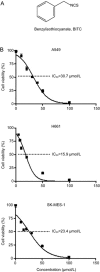
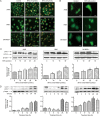
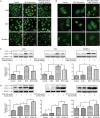


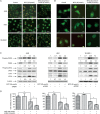

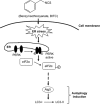
Similar articles
-
Inhibition of autophagy potentiates the anti-metastasis effect of phenethyl isothiocyanate through JAK2/STAT3 pathway in lung cancer cells.Mol Carcinog. 2018 Apr;57(4):522-535. doi: 10.1002/mc.22777. Epub 2018 Jan 17. Mol Carcinog. 2018. PMID: 29278657
-
Phenethyl isothiocyanate synergistically induces apoptosis with Gefitinib in non-small cell lung cancer cells via endoplasmic reticulum stress-mediated degradation of Mcl-1.Mol Carcinog. 2020 Jun;59(6):590-603. doi: 10.1002/mc.23184. Epub 2020 Mar 18. Mol Carcinog. 2020. PMID: 32189414
-
Benzyl isothiocyanate causes FoxO1-mediated autophagic death in human breast cancer cells.PLoS One. 2012;7(3):e32597. doi: 10.1371/journal.pone.0032597. Epub 2012 Mar 22. PLoS One. 2012. PMID: 22457718 Free PMC article.
-
Inhibition of autophagy enhances heat-induced apoptosis in human non-small cell lung cancer cells through ER stress pathways.Arch Biochem Biophys. 2016 Oct 1;607:55-66. doi: 10.1016/j.abb.2016.08.016. Epub 2016 Aug 24. Arch Biochem Biophys. 2016. PMID: 27565443 Review.
-
Chemoprevention of cancer by isothiocyanates, modifiers of carcinogen metabolism.J Nutr. 1999 Mar;129(3):768S-774S. doi: 10.1093/jn/129.3.768S. J Nutr. 1999. PMID: 10082787 Review.
Cited by
-
Moringa isothiocyanate complexed with α-cyclodextrin: a new perspective in neuroblastoma treatment.BMC Complement Altern Med. 2017 Jul 14;17(1):362. doi: 10.1186/s12906-017-1876-z. BMC Complement Altern Med. 2017. Retraction in: BMC Complement Med Ther. 2023 Mar 7;23(1):75. doi: 10.1186/s12906-023-03908-x. PMID: 28705212 Free PMC article. Retracted.
-
Natural Compounds from Herbs that can Potentially Execute as Autophagy Inducers for Cancer Therapy.Int J Mol Sci. 2017 Jul 1;18(7):1412. doi: 10.3390/ijms18071412. Int J Mol Sci. 2017. PMID: 28671583 Free PMC article. Review.
-
Inhibiting autophagy enhances sulforaphane-induced apoptosis via targeting NRF2 in esophageal squamous cell carcinoma.Acta Pharm Sin B. 2021 May;11(5):1246-1260. doi: 10.1016/j.apsb.2020.12.009. Epub 2020 Dec 15. Acta Pharm Sin B. 2021. PMID: 34094831 Free PMC article.
-
Epigenetics/Epigenomics and Prevention of Early Stages of Cancer by Isothiocyanates.Cancer Prev Res (Phila). 2021 Feb;14(2):151-164. doi: 10.1158/1940-6207.CAPR-20-0217. Epub 2020 Oct 14. Cancer Prev Res (Phila). 2021. PMID: 33055265 Free PMC article. Review.
-
BAG3 Protein Is Involved in Endothelial Cell Response to Phenethyl Isothiocyanate.Oxid Med Cell Longev. 2018 May 31;2018:5967890. doi: 10.1155/2018/5967890. eCollection 2018. Oxid Med Cell Longev. 2018. PMID: 29955247 Free PMC article.
References
-
- Ferlay J, Soerjomataram I, Dikshit R, Eser S, Mathers C, Rebelo M, et al. Cancer incidence and mortality worldwide: Sources, methods and major patterns in GLOBOCAN 2012. Int J Cancer 2015; 136: E359–86. - PubMed
-
- DeSantis CE, Lin CC, Mariotto AB, Siegel RL, Stein KD, Kramer JL, et al. Cancer treatment and survivorship statistics, 2014. CA Cancer J Clin 2014; 64: 252–71. - PubMed
-
- Mizushima N, Komatsu M. Autophagy: renovation of cells and tissues. Cell 2011; 147: 728–41. - PubMed
-
- Choi AM, Ryter SW, Levine B. Autophagy in human health and disease. N Engl J Med 2013; 368: 1845–6. - PubMed
MeSH terms
Substances
LinkOut - more resources
Full Text Sources
Other Literature Sources
Medical
Research Materials
Miscellaneous

